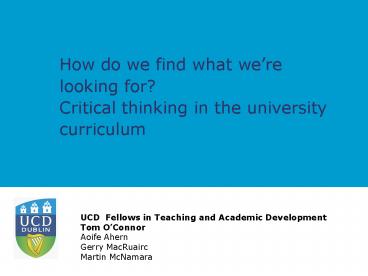How do we find what we - PowerPoint PPT Presentation
1 / 10
Title:
How do we find what we
Description:
How do we find what we re looking for? Critical thinking in the university curriculum UCD Fellows in Teaching and Academic Development Tom O Connor – PowerPoint PPT presentation
Number of Views:85
Avg rating:3.0/5.0
Title: How do we find what we
1
How do we find what were looking for? Critical
thinking in the university curriculum
UCD Fellows in Teaching and Academic Development
Tom OConnor Aoife Ahern Gerry MacRuairc
Martin McNamara
2
Fellowships in Teaching and Academic Development
- Initiative under Strategic Innovation Fund
- Purpose Conduct research which is of strategic
importance to the development of teaching and
learning in UCD - 2009-2011 (7 fellows)
- http//www.ucd.ie/fellows/
3
Teaching for transitions Graduate Attributes
- Need for universities to clarify the nature of
the education they provide and clarifying the
contributions of their graduates to society - Impetus to describe graduate attributes
- Employers
- Policy makers
- Professional groups/organisations
- Local UCD education strategy
- What are they?
- Qualities, skills and understanding gained as a
result of university education - Generic and beyond purely disciplinary boundaries
- Prepares graduate not only for employment but as
agents for social good - Tensions skills versus attributes, Generic
versus specific. - (Bowden et al 2000 Barrie 2006, 2007, Jones 2009)
4
Critical thinking
- Considered a (the) key graduate attribute
- Difficulty in definition
- Cognitive skill
- Linked variously to logic, problem solving,
scepticism examining evidence, exploring
contradictions/complexities, development of
argument, open mindedness. - 3 tiered model (Barnett 1997)
- Critical thinking (learning generally to problem
solve) - Critical thought (using this skill to interrogate
a body of knowledge) - Critique (meta-criticism, can go beyond the
discipline) - (Pithers Soden 2000, Davies 2006, Jones
2007a,2007b, 2009)
5
Critical thinking
- Discipline specific or a generic attribute?
- Linked to epistemic culture (Jones 2007)
- Generalists versus the specifists (Davies
2006) - Teaching and learning implications
- (How) Can it be taught or learned?
- Is it a subject in itself or incorporated within
disciplinary knowledge - Curriculum design and delivery strategies
6
The Project
- Aim
- Explore the understandings and realisation of
critical thinking in the university curriculum - Objectives
- Elicit and explore academics understanding of
critical thinking as a generic graduate
attribute - Elicit and explore academics understandings of
critical thinking within the context of their
discipline or subject area - Examine how academics understandings of critical
thinking are realised in curriculum design.
7
The Project
- Multi-method qualitative study, approaching 10
schools. - Semi structured interviews with 10 subject
experts to elicit their views on critical
thinking - Semi structured interviews with 20 module
coordinators as to how critical thinking is
incorporated into their module - Documentary analysis of 20 module descriptors
looking for presence of critical thinking - Documentary analysis of 3 pieces of student work
(from each module above, 60 in total)
8
Projected outcomes
- Provide a general insight of critical thinking as
a attribute of university education in UCD. - Provide an insight into academics understanding
of critical thinking as a generic graduate
attribute and detailing the manner in which
critical thinking is positioned and developed
within a disciplinary context. - Provide an insight into the realisation of
critical thinking in the curriculum - Recommendations with regard to
- (a) Module design and structure,
- (b) Teaching and learning strategies,
- (c) Assessment strategies.
9
- Thank you
10
References
- Barrie S. (2006) Understanding what we mane by
the generic attributes if graduates. Higher
Education 51 pp 215-241 - Barrie S. (2007) A conceptual framework for the
teaching and learning of generic graduate
attributes. Studies in Higher Education 32(4) pp
439-458. - Barnett R. (1997) Higher Education A critical
business. Open University Press, Buckingham. - Davies W. M. (2006) An infusion approach to
critical thinking Moore on the critical thinking
debate. Higher Education Research and Development
25(2) pp 179-193. - Jones A. ( 2007) Multiplicities or manna from
heaven? Critical thinking and the disciplinary
context, Australian Journal of Education Vol. 51,
No. 1, 84103. - Jones A. (2007) Looking over our shoulders
Critical thinking and ontological insecurity in
higher education, London Review of Education. - Jones A. (2009) Generic attribute as espoused
theory the importance of context. Higher
Education 58 p175-191. - Maton K. (2009) Cumulative and segmented
learning exploring the role ofcurriculum
structures in knowledge-building in British
Journal of Sociology of Education 30(1) pp 4357
- Pithers R.T Soden R (2000) Critical thinking in
education a review. Educational Research (42)3 - Pitman T. Broomhall S. (2000) Australian
universities, generic skills and lifelong
learning. International Journal of Lifelong
Education 28(4) pp 439-458.































